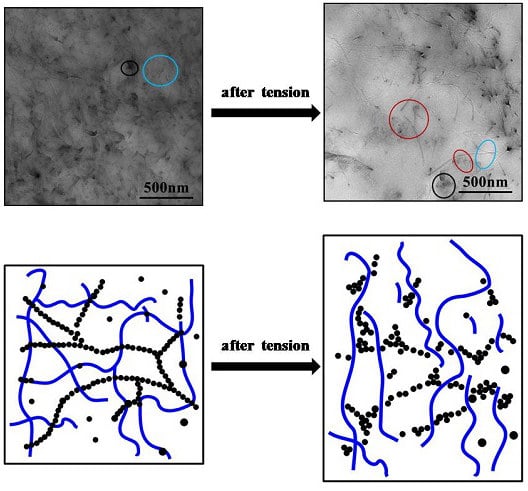Synchronously Tailoring Strain Sensitivity and Electrical Stability of Silicone Elastomer Composites by the Synergistic Effect of a Dual Conductive Network
Abstract
:1. Introduction
2. Experimental Section
2.1. Materials
2.2. Preparation of Composites
2.3. Characterizations
3. Results
3.1. Electrical and Mechanical Properties
3.2. Strain-Sensing Behavior of Composites
3.2.1. Resistance-Strain Sensitivity
3.2.2. Repeatability of Dynamic Strain-Sensing Behavior
3.3. Electrical Stability under Fatigue Cycles
4. Discussion
Relation of the Conductive Filler Network and the Strain-Sensing Behavior and Electrical Stability
5. Conclusions
Acknowledgments
Author Contributions
Conflicts of Interest
References
- Chung, D.D.L. Electromagnetic interference shielding effectiveness of carbon materials. Carbon 2001, 39, 279–285. [Google Scholar] [CrossRef]
- Stoyanov, H.; Kollosche, M.; Risse, S.; Waché, R.; Kofod, G. Soft conductive elastomer materials for stretchable electronics and voltage controlled artificial muscles. Adv. Mater. 2013, 25, 578–583. [Google Scholar] [CrossRef] [PubMed]
- Choong, C.L.; Shim, M.B.; Lee, B.S.; Jeon, S.; Ko, D.S.; Kang, T.H.; Bae, J.; Lee, S.H.; Byun, K.E.; Im, J.; et al. Highly stretchable resistive pressure sensors using a conductive elastomeric composite on a micropyramid array. Adv. Mater. 2014, 26, 3451–3458. [Google Scholar] [CrossRef] [PubMed]
- Yi, W.J.; Wang, Y.Y.; Wang, G.F.; Tao, X.M. Investigation of carbon black/silicone elastomer/dimethylsilicone oil composites for flexible strain sensors. Polym. Test. 2012, 31, 677–684. [Google Scholar] [CrossRef]
- Wang, L.H.; Li, Y. A Review for conductive polymer piezoresistive composites and a development of a compliant pressure transducer. IEEE Trans. Instrum. Meas. 2013, 62, 495–502. [Google Scholar] [CrossRef]
- Hou, Y.; Wang, D.R.; Zhang, X.M.; Zhao, H.; Zha, J.W.; Dang, Z.M. Positive piezoresistive behavior of electrically conductive alkyl-functionalized graphene/polydimethylsilicone nanocomposites. J. Mater. Chem. C 2013, 1, 515–521. [Google Scholar] [CrossRef]
- Lu, N.S.; Lu, C.; Yang, S.X.; Rogers, J. Highly sensitive skin-mountable strain gauges based entirely on elastomers. Adv. Funct. Mater. 2012, 22, 4044–4050. [Google Scholar] [CrossRef]
- Pavlovsky, S.; Siegmann, A. Chemical sensing materials. I. Electrically conductive SEBS copolymer systems. J. Appl. Polym. Sci. 2009, 113, 3322–3329. [Google Scholar] [CrossRef]
- Zhang, R.; Deng, H.; Valenca, R.; Jin, J.H.; Fu, Q.; Bilotti, E.; Peijs, P. Carbon nanotube polymer coatings for textile yarns with good strain sensing capability. Sens. Actuators A 2012, 179, 83–91. [Google Scholar] [CrossRef]
- Eswaraiah, V.; Balasubramaniam, K.; Ramaprabhu, S. Functionalized graphene reinforced thermoplastic nanocomposites as strain sensors in structural health monitoring. J. Mater. Chem. 2011, 21, 12626–12628. [Google Scholar] [CrossRef]
- Yamada, T.; Hayamizu, Y.; Yamamoto, Y.; Yomogida, Y.; Izadi-Najafabadi, A.; Futaba, D.N.; Hata, K. A stretchable carbon nanotube strain sensor for human-motion detection. Nat. Nanotechnol. 2011, 6, 296–301. [Google Scholar] [CrossRef] [PubMed]
- Zhao, J.H.; Dai, K.; Liu, C.G.; Zheng, G.Q.; Wang, B.; Liu, C.T.; Chen, J.B.; Shen, C.Y. A comparison between strain-sensing behaviors of carbon black/polypropylene and carbon nanotubes/polypropylene electrically conductive composites. Compos. A 2013, 48, 129–136. [Google Scholar] [CrossRef]
- Dang, Z.M.; Jiang, M.J.; Xie, D.; Yao, S.H.; Zhang, L.Q.; Bai, J. Supersensitive linear piezoresistive property in carbon nanotubes/silicone rubber nanocomposites. J. Appl. Phys. 2008, 104, 1–6. [Google Scholar] [CrossRef]
- Costa, P.; Silvia, C.; Viana, J.C.; Lanceros-Mendez, S. Extruded thermoplastic elastomers styrene-butadiene-styrene/carbon nanotubes composites for strain sensor applications. Compos. B 2014, 57, 242–249. [Google Scholar] [CrossRef]
- Costa, P.; Silva, J.; Ansón-Casaos, A.; Martinez, M.T.; Abad, M.J.; Viana, J.; Lanceros-Mendez, S. Effect of carbon nanotube type and functionalization on the electrical, thermal, mechanical and electromechanical properties of carbon nanotube/styrene-butadiene-styrene composites for large strain sensor applications. Compos. B 2014, 61. [Google Scholar] [CrossRef]
- Fathi, A.; Hatami, K.; Grady, B.P. Effect of carbon black structure on low-strain conductivity of polypropylene and low-density polyethylene composites. Polym. Eng. Sci. 2012, 52, 549–556. [Google Scholar] [CrossRef]
- Knite, M.; Teteris, V.; Kiploka, A.; Kaupuzs, J. Polyisoprene-carbon black nanocomposites as tensile strain and pressure sensor materials. Sens. Actuators A 2004, 110, 142–149. [Google Scholar] [CrossRef]
- Georgousis, G.; Pandis, C.; Kalamiotis, A.; Georgiopoulos, P.; Kyritsis, A.; Kontou, E.; Pissis, P.; Micusik, M.; Czanikova, K.; Kulicek, J.; et al. Strain sensing in polymer/carbon nanotube composites by electrical resistance measurement. Compos. B 2015, 68, 162–169. [Google Scholar] [CrossRef]
- Lin, L.; Deng, H.; Gao, X.; Zhang, S.M.; Bilotti, E.; Peijs, T.; Fu, Q. Modified resistivity-strain behavior through the incorporation of metallic particles in conductive polymer composite fibers containing carbon nanotubes. Polym. Int. 2013, 62, 134–140. [Google Scholar] [CrossRef]
- Ji, M.Z.; Deng, H.; Yan, D.X.; Li, X.Y.; Duan, L.Y.; Fu, Q. Selective localization of multi-walled carbon nanotubes in thermoplastic elastomer blends: An effective method for tunable resistivity-strain-sensing behavior. Compos. Sci. Technol. 2014, 92, 16–26. [Google Scholar] [CrossRef]
- Lin, L.; Liu, S.Y.; Zhang, Q.; Li, X.Y.; Ji, M.Z.; Deng, H.; Fu, Q. Towards tunable sensitivity of electrical property to strain for conductive polymer composites based on thermoplastic elastomer. ACS Appl. Mater. Interfaces 2013, 5, 5815–5824. [Google Scholar] [CrossRef] [PubMed]
- Witt, N.; Tang, Y.H.; Ye, L.; Fang, L.M. Silicone rubber nanocomposites containing a small amount of hybrid fillers with enhanced electrical sensitivity. Mater. Des. 2013, 45, 548–554. [Google Scholar] [CrossRef]
- Slobodian, P.; Riha, P.; Saha, P. A highly-deformable composite composed of an entangled network of electrically-conductive carbon-nanotubes embedded in elastic polyurethane. Carbon 2012, 50, 3446–3453. [Google Scholar] [CrossRef]
- Sobha, A.P.; Narayanankutty, S.K. Improved strain sensing property of functionalized multiwalled carbon nanotube/polyaniline composites in TPU matrix. Sens. Actuators A 2015, 233, 98–107. [Google Scholar] [CrossRef]
- Dai, H.; Thostenson, E.T.; Schumacher, T. Processing and Characterization of a novel distributed strain sensor using carbon nanotube-based nonwoven composites. Sensors 2015, 15, 17728–17747. [Google Scholar] [CrossRef] [PubMed]
- Ning, N.Y.; Ji, L.J.; Zhang, L.Q.; Liu, J.; Lu, Y.L.; Wu, S.M.; Zou, H.; Tian, M.; Chan, T.W. High elasticity and conductivity of elastomer composites with arrayed carbon nanotubes as nanosprings. Compos. Sci. Technol. 2015, 118, 78–84. [Google Scholar] [CrossRef]
- Ning, N.Y.; Zhang, W.; Yan, J.J.; Xu, F.; Wang, T.N.; Su, H.; Tang, C.Y.; Fu, Q. Largely enhanced crystallization of semi-crystalline polymer on the surface of glass fiber by using graphene oxide as a modifier. Polymer 2013, 54, 303–309. [Google Scholar] [CrossRef]


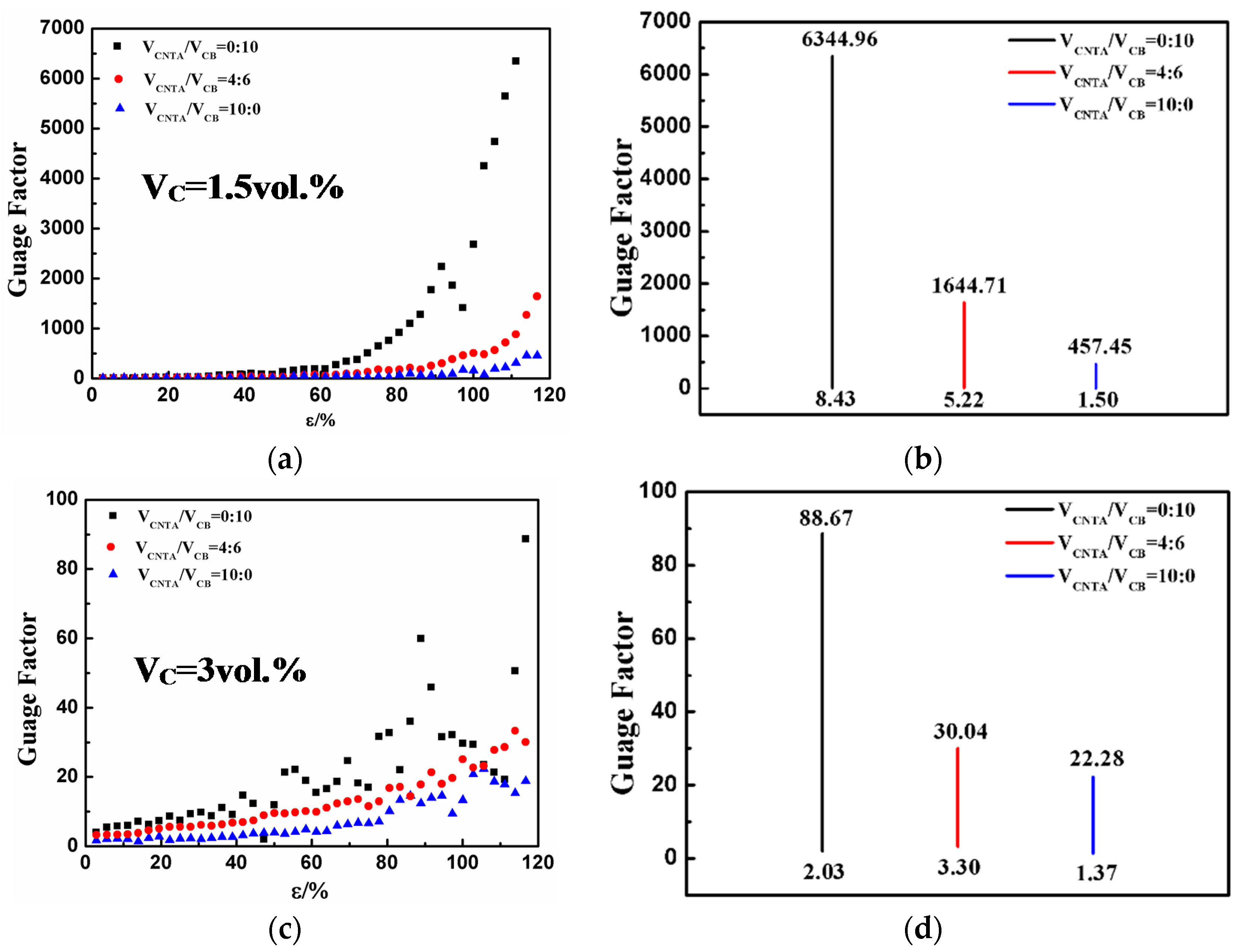
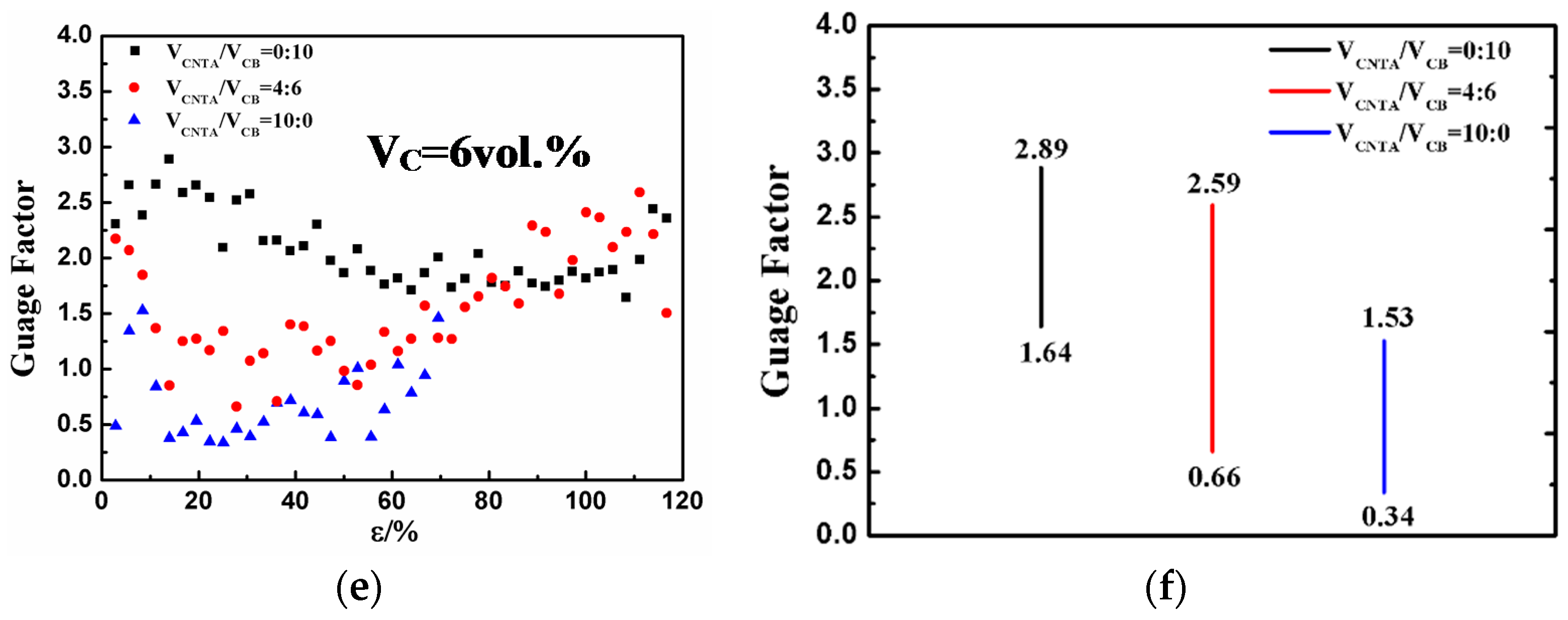

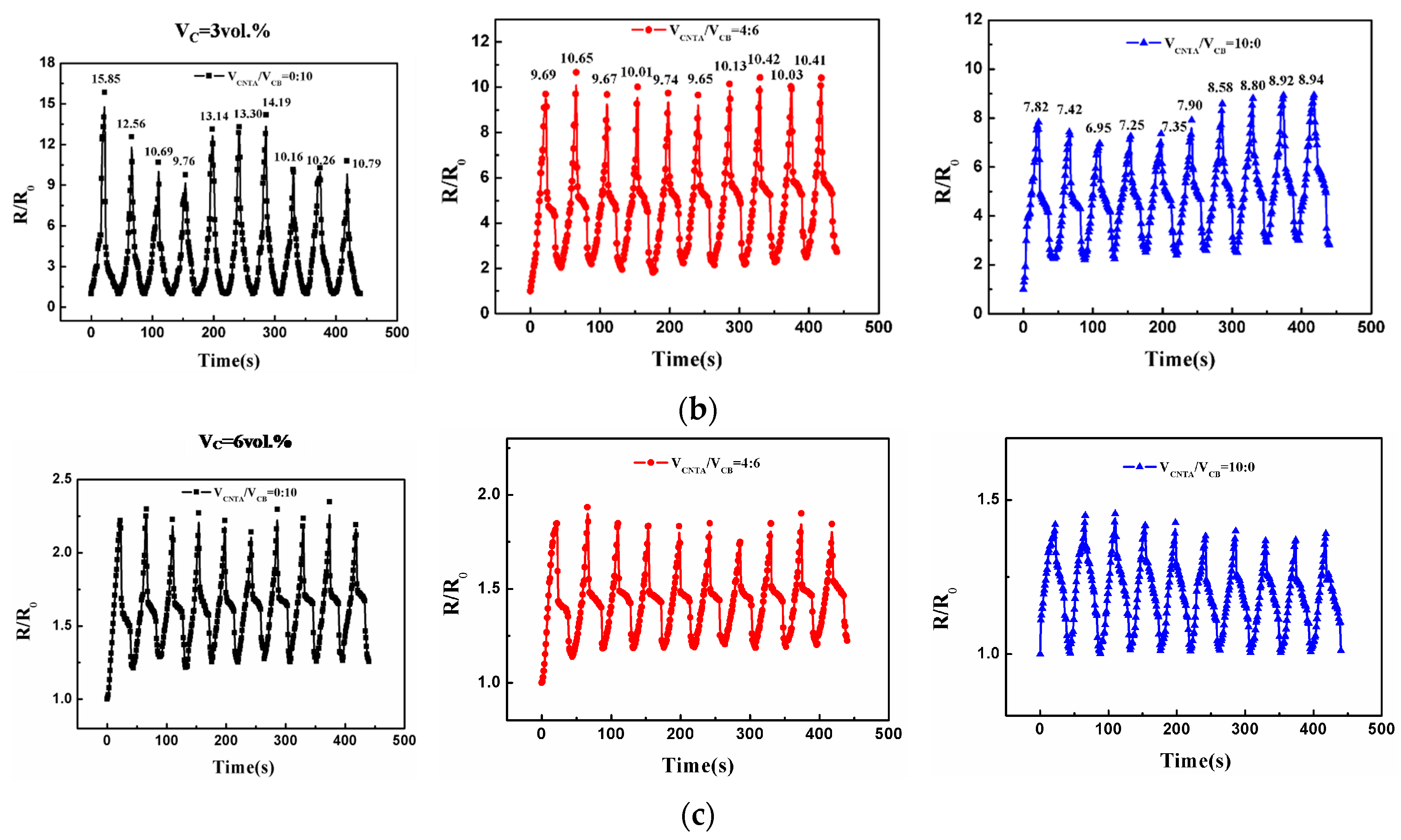
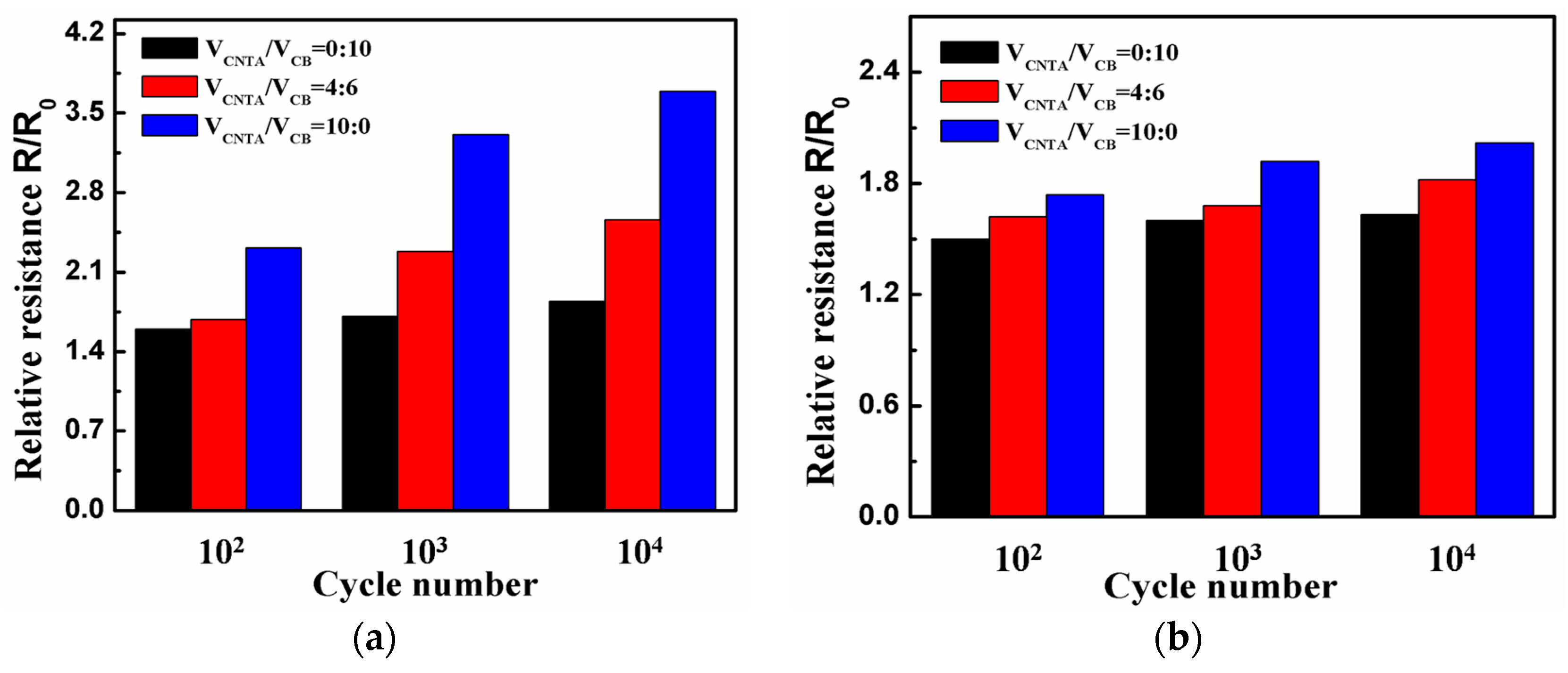
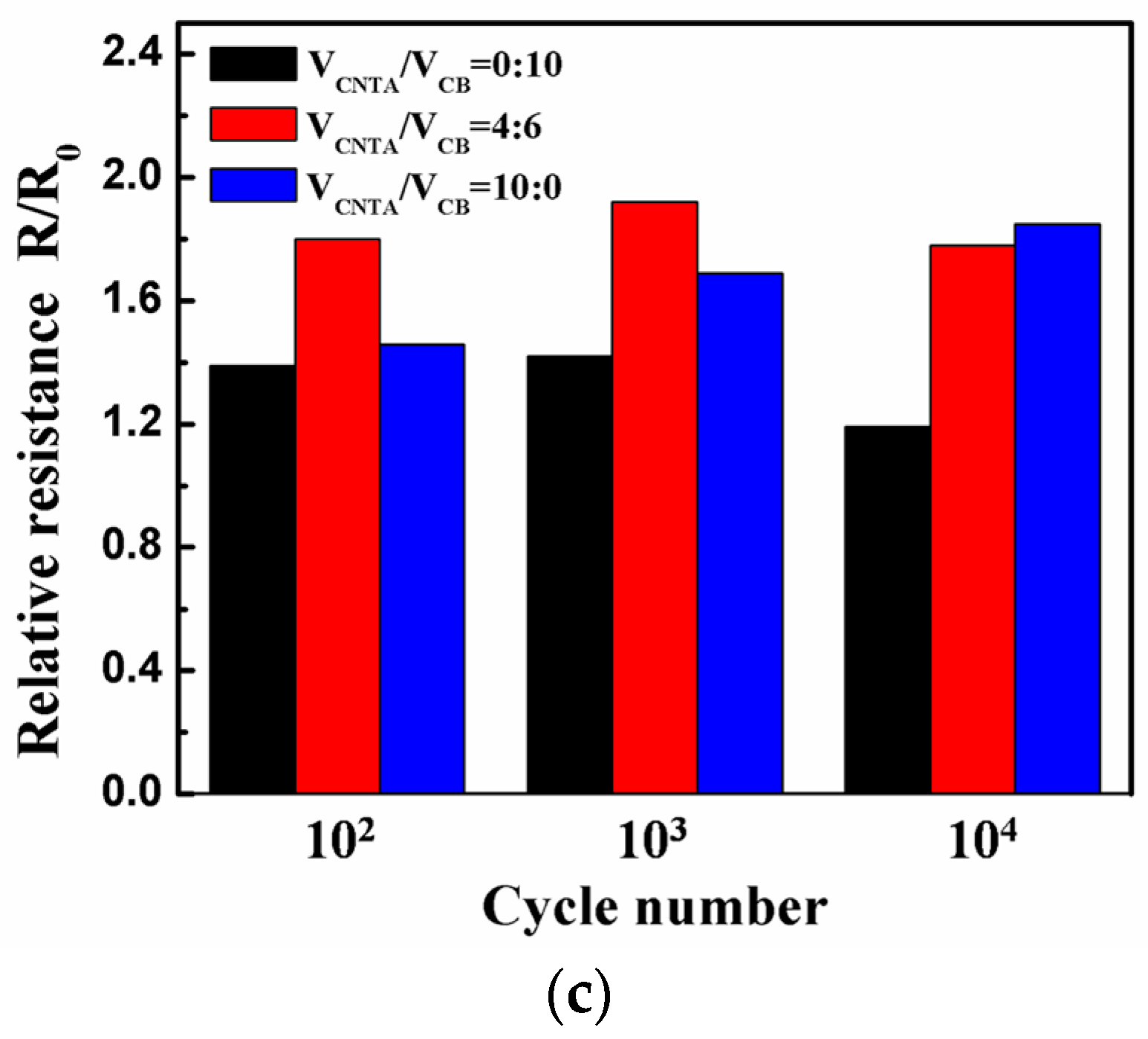
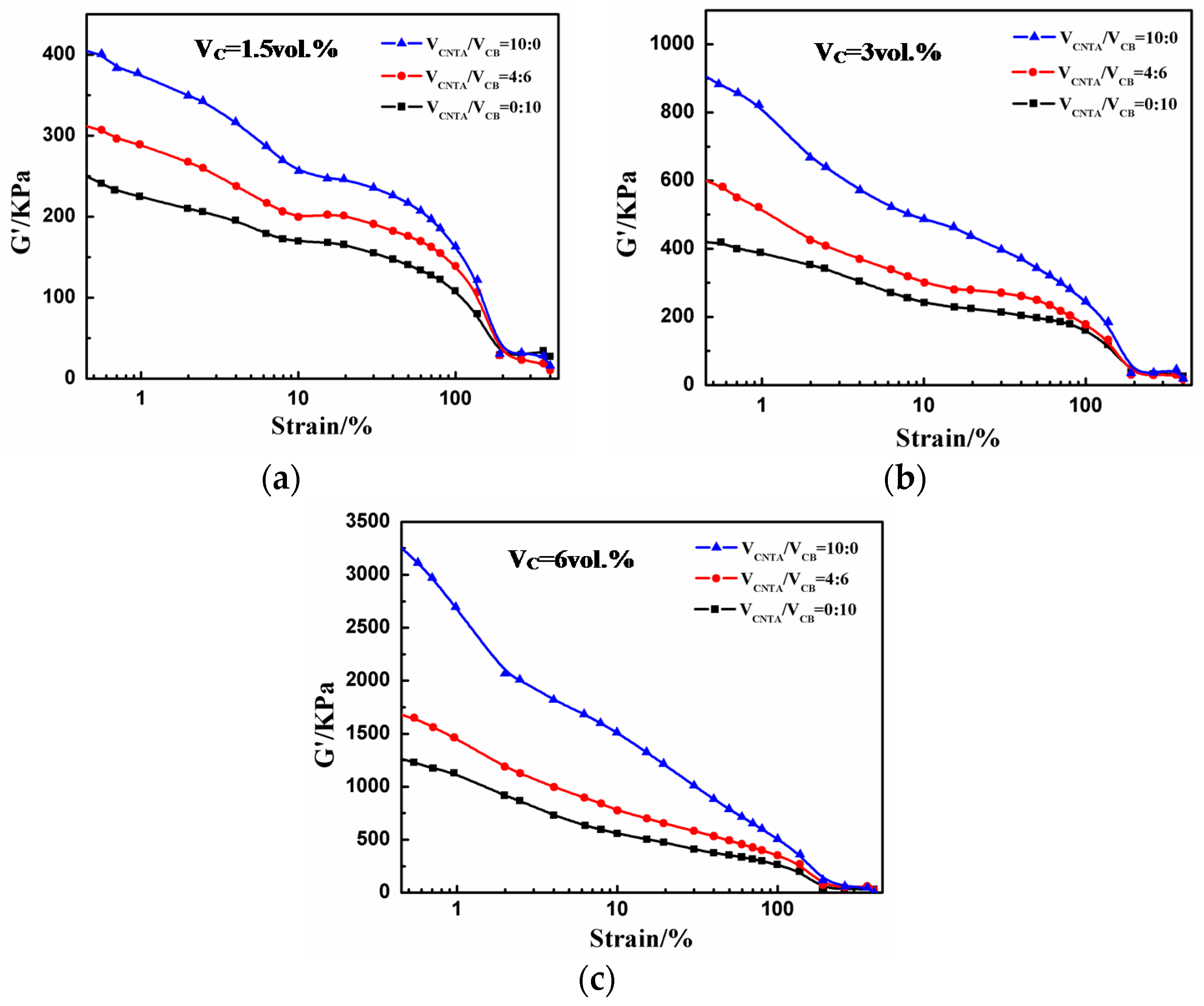


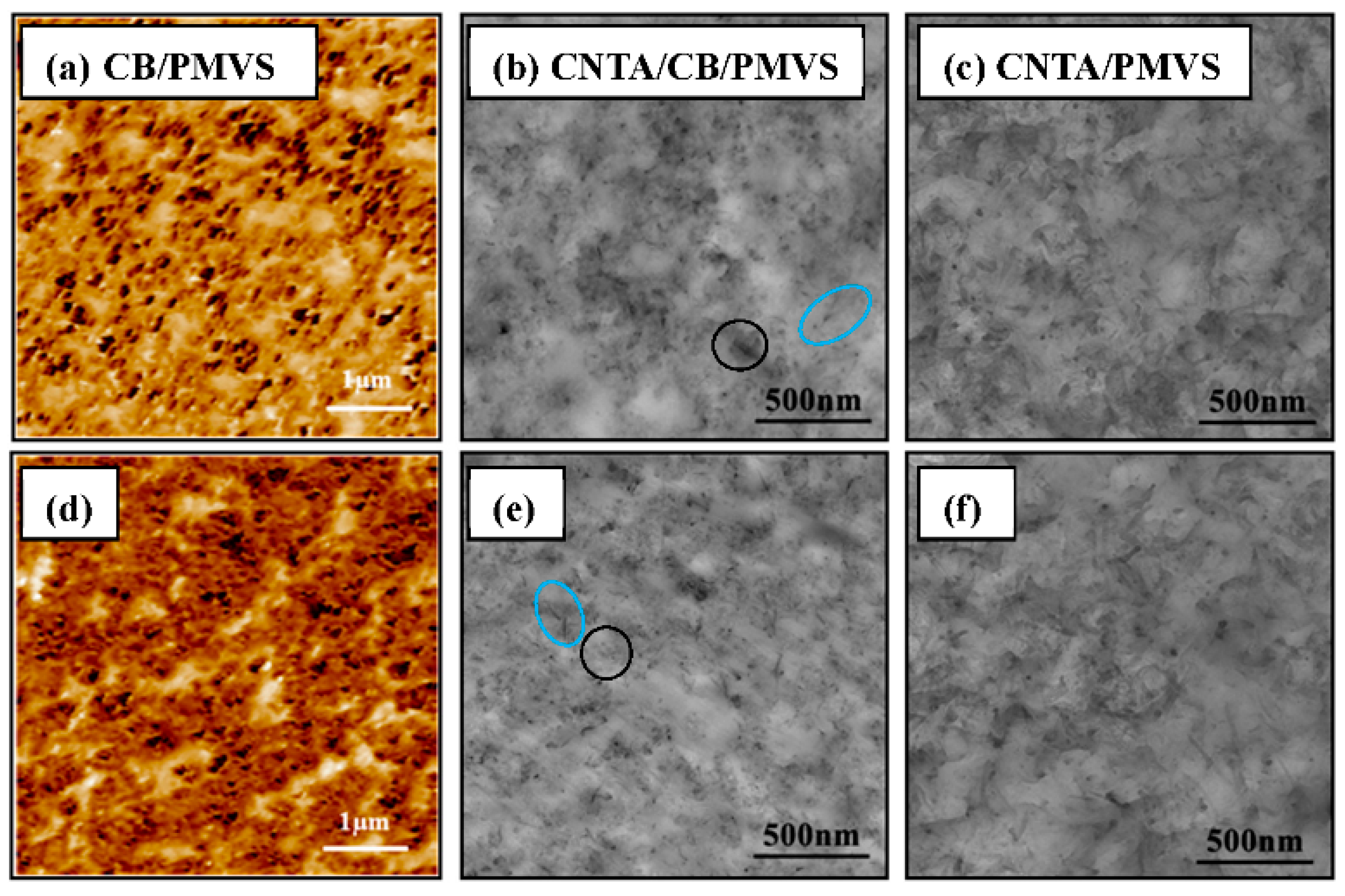
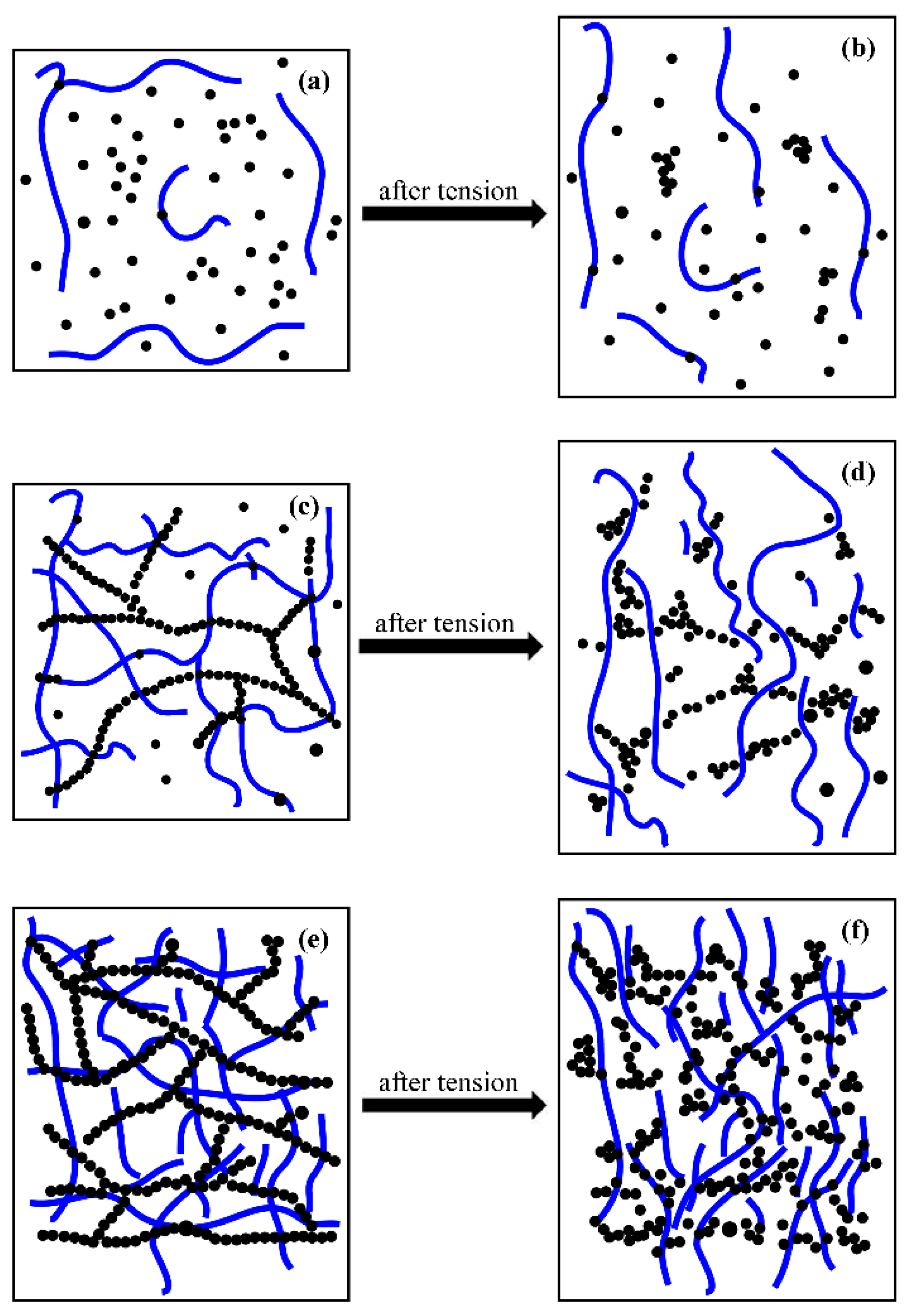
| Test items | Tensile strength (MPa) | Strain to failure (%) | Volume resistivity (Ω·cm) | |
|---|---|---|---|---|
| Filler volume fraction and ratio | ||||
| VC = 1.5 vol % | VCNTA/VCB = 0:10 | 0.4 | 213 | 1.2 × 1011 |
| VCNTA/VCB = 4:6 | 0.8 | 163 | 2.8 × 108 | |
| VCNTA/VCB = 10:0 | 1.3 | 133 | 8.3 × 106 | |
| VC = 3 vol % | VCNTA/VCB = 0:10 | 1.2 | 250 | 3,112.1 |
| VCNTA/VCB = 4:6 | 1.8 | 180 | 854.0 | |
| VCNTA/VCB = 10:0 | 3.2 | 120 | 207.7 | |
| VC = 6 vol % | VCNTA/VCB = 0:10 | 2.9 | 259 | 12.2 |
| VCNTA/VCB = 4:6 | 3.2 | 128 | 4.9 | |
| VCNTA/VCB = 10:0 | 5.4 | 78 | 3.3 |
© 2016 by the authors. Licensee MDPI, Basel, Switzerland. This article is an open access article distributed under the terms and conditions of the Creative Commons by Attribution (CC-BY) license ( http://creativecommons.org/licenses/by/4.0/).
Share and Cite
Ning, N.; Wang, S.; Zhang, L.; Lu, Y.; Tian, M.; Chan, T.W. Synchronously Tailoring Strain Sensitivity and Electrical Stability of Silicone Elastomer Composites by the Synergistic Effect of a Dual Conductive Network. Polymers 2016, 8, 100. https://doi.org/10.3390/polym8040100
Ning N, Wang S, Zhang L, Lu Y, Tian M, Chan TW. Synchronously Tailoring Strain Sensitivity and Electrical Stability of Silicone Elastomer Composites by the Synergistic Effect of a Dual Conductive Network. Polymers. 2016; 8(4):100. https://doi.org/10.3390/polym8040100
Chicago/Turabian StyleNing, Nanying, Sishu Wang, Liqun Zhang, Yonglai Lu, Ming Tian, and Tung W. Chan. 2016. "Synchronously Tailoring Strain Sensitivity and Electrical Stability of Silicone Elastomer Composites by the Synergistic Effect of a Dual Conductive Network" Polymers 8, no. 4: 100. https://doi.org/10.3390/polym8040100
APA StyleNing, N., Wang, S., Zhang, L., Lu, Y., Tian, M., & Chan, T. W. (2016). Synchronously Tailoring Strain Sensitivity and Electrical Stability of Silicone Elastomer Composites by the Synergistic Effect of a Dual Conductive Network. Polymers, 8(4), 100. https://doi.org/10.3390/polym8040100





